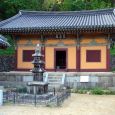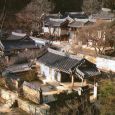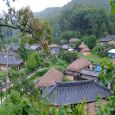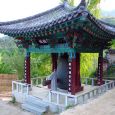Andong
Advertisement
By Train
There are regular direct services from Busan, Daegu and Gwangju. Passengers heading from Seoul can either take a KTX high-speed service to Daegu and transfer to the local train, or a muhgunghwa (semi-fast) train direct from Seoul's Cheongnyangni train. Andong's train station is located right in the city centre and most hotels can be reached within 5 minutes walk. The station has English-speaking staff, self-service ticket machines, a Global ATM and a tourist information centre.
By Bus
Andong is quite easily accessible on the Inter-city bus network. Bear in mind that it's usually best to pre-book your ticket or at least try to confirm departure times online.
From East Seoul Terminal Located out the front of Kangbyeon station (subway no.2-green line) The buses go every 10~15 minutes to Andong and it takes 2 hours, 40 minutes.
From Kangnam (Seoul) Express Terminal Located in Kangnam Express Bus Terminal-station(subway no.3 and no.7-orange&olive green) It's easier to find the terminal by getting into the Sinsegye Department Store and going via the FENDI & GUCCI store (1F) because the way between those stores is connected by the terminal. The buses go every 40~60 minutes to Andong and it takes 2 hours, 50 minutes.
Andong Hahoe Folk Village
Various cultural assets including national treasures and tangible or intangible cultural heritages are well preserved in the Andong Hahoe Folk Village, and the whole village was designated as Important Folk Material No.122, also a listed UNESCO World Heritage Site since 2010. People live in every house in the village and you can enjoy the true folk culture of Korea there. They provide the traditional Korean mask dance on weekends (3 pm, every Sunday in March, April, November / 3 pm, every Saturday and Sunday from May to October).
Bongjeongsa
Bongjeongsa is a Korean Buddhist temple on the slopes of Mount Cheondeung in Andong city, North Gyeongsang Province, South Korea. It is a subsidiary temple of Gounsa, the head temple of the 16th branch of Jogye Order.
Bongjeongsa is the largest temple in Andong, and is the site of the oldest wooden building, Geuknakjeon, in Korea.There are 10 buildings at the main temple and a total of 9 other buildings at Bongjeongsa's two sub temples found to the east and west of the main temple complex.
The tree inhabited by the Samshin-goddes
The tree inhabited by the Samshin-goddes, Walk around it three times, and write your wish on a tag. Peace or reuinification seem to be common answers if stumped. The sight alone of all the aging tags hung off such an ancient tree is worth a peek.
Byongdae Cliff
The view from atop showcases the entire village and is rather spectacular. Take the little wooden ferry from down by the pine forest, it's pretty cheap and return is included. Those feeling adventurous can note that its actually possible to descend or ascend the cliff not only by taking the main trail beside Okyeon Pavillion, but also by a lesser marked one that goes via Gyeomam Pavillion, following the strata along the cliff-face itself, halfway up. Not for oversized individuals or those wary of heights.
Yangdong Folk Village
Yangdong Folk Village is a traditional village from the Joseon Dynasty. The village is located in Gangdong-myeon, sixteen kilometers northeast of Gyeongju, Gyeongsangbuk-do, South Korea, along the Hyeongsan River. Mt. Seolchang stands to the north of the village. The village is designated as Important Folklore Materials No. 189 by the South Korean government.
The size, degree of preservation, numerous cultural assets, traditionalism, beautiful natural setting all contribute to the importance of Yangdong Village. It is also a fine example of the yangban lifestyle and Neo-Confucian traditions.
The village is listed by the South Korean government with UNESCO as a World Heritage site with Hahoe Folk Village in 2010.
Information not available





